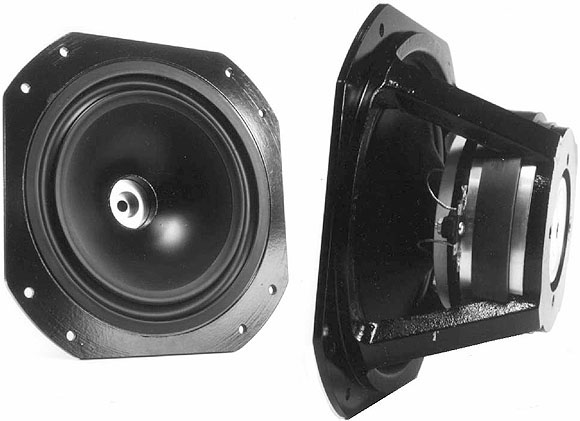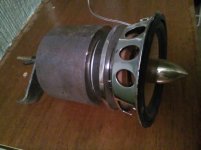It reduces the movement due to the reaction force? As far as I'm aware the only effect of the driver not being "mechanically grounded" is a slight reduction in SPL.
And loss of DDR,
dave
I don't see why there would be any loss of DDR per se.
If the basket moves, ie it is not anchored in space, every little movement buries anything smaller than the movement gets lost, so one gets a loss of DDR due to the information being buried by the movement.
dave
Is that a measurable defect? Is the ambient sound and general decay that is indicative of a direct to disc opposed to a regular example of the same analog recording measurable? Is this an issue with digital recordings?If the basket moves, ie it is not anchored in space, every little movement buries anything smaller than the movement gets lost, so one gets a loss of DDR due to the information being buried by the movement.
dave
It's basically unloading the speaker frame and mounting flange from the alternating force of the VC. One would think that the speaker basket / flange would be infinitely stiff, but it's not. The magnet pole piece / assembly - the thing the VC first pushes against that by definition must react - is way stiffer.
So butt your infinite mass up against that and the basket / flange doesnt have to do anything much mechanically except hold the cone in place and keep it centered. All you have to do when using a pole-piece mount is pneumatically seal the flange to the baffle.
Someone should invent a threaded affair as part of the magnet pole, so you can just screw your driver down against the baffle seal. Put a pin in it to keep it from turning. Hexagonal flange and a big matching wrench.
But no, every speaker manufacturer there is uses multiple screws around the flange periphery because that's the way we've always done and...and what else is there?
So butt your infinite mass up against that and the basket / flange doesnt have to do anything much mechanically except hold the cone in place and keep it centered. All you have to do when using a pole-piece mount is pneumatically seal the flange to the baffle.
Someone should invent a threaded affair as part of the magnet pole, so you can just screw your driver down against the baffle seal. Put a pin in it to keep it from turning. Hexagonal flange and a big matching wrench.
But no, every speaker manufacturer there is uses multiple screws around the flange periphery because that's the way we've always done and...and what else is there?
If the basket moves, ie it is not anchored in space, every little movement buries anything smaller than the movement gets lost, so one gets a loss of DDR due to the information being buried by the movement.
dave
For some reason you seem to think that if the driver moves it is "blurring" detail or information is "lost". You have mentioned this earlier in your comments this thread, but I just do not see how that is correct.
Let me as you, what is 0.9 times 10? It's 9. Now 9 is just 9/10ths of 10, so its' just like 10, just smaller. This is exactly what happens if a driver frame moves in reaction to the motor pushing the cone. Assuming that there is no static friction component then all movements of the frame are just a linear fraction of the cone movement. Whatever the cone is doing, the frame will also be doing, just with much less amplitude due to the mass ratio between the two. The movement of the frame is simply taking away some cone movement by its own and opposite movement, and the result is just a linear SPL loss. It should be proportionally linear down to the minute-est little component and would be no different than turning down the volume by 1dB or the like.
The amount of SPL loss from this effect is very, very small. If the cone and frame mass were THE SAME (!) then the loss would be only 3dB (or is it 6dB, not sure). But when the frame and magnet weigh 2kg and the cone weighs 50g, there is a HUGE mass ratio that means the frame will move proportionally much less than the cone, meaning losses are well under 1dB.
The problem comes when the "soft mounting" is non-linear or only works above some threshold because of stick-slip friction. Then there is a kind of diode effect, but at worst case its moving between free movement (which become the case I mentioned above) or stuck movement (which is just like a firm mounting, of which you seem to be a proponent).
Given all of this, what am I missing that forms your basis for claiming "losses"???
Last edited:
No, the cone's effective mass is dramatically increased due to force factor. Loss is loss as you point out. The question is whether the effect is actually noticeable at low level resolution which is what DDR is. I would say no just because the reciprocal effect must increase logarithmically with power/spl. So low level resolution remains unaffected in practical terms. The strength of the structure overpowers the effect exponentially at the lowest volumes where DDR/low level resolution lives.
OTOH, consensus on the Kef 105 series 1 vs. 2 was that the original series sounded better, even though sensitivity was the same.
OTOH, consensus on the Kef 105 series 1 vs. 2 was that the original series sounded better, even though sensitivity was the same.
Primarily, yes. Would it be worth checking for the basket resonance, assuming it is significant it would change with mounting method?It reduces the movement due to the reaction force? As far as I'm aware the only effect of the driver not being "mechanically grounded" is a slight reduction in SPL.
Someone should invent a threaded affair as part of the magnet pole, so you can just screw your driver down against the baffle seal.
These are designed to be bolted to a solid bit at the back. Or 2 bolted together push-push. Then a stick on felt cap over the bolt head
PEARL PR-2 Woofer

dave
That could explain what lasercut is hearing.Primarily, yes. Would it be worth checking for the basket resonance, assuming it is significant it would change with mounting method?
You can do the same with cheap coaxial car speakers, if you remove the tweeter


These are designed to be bolted to a solid bit at the back. Or 2 bolted together push-push. Then a stick on felt cap over the bolt head
PEARL PR-2 Woofer
dave
The unanswered question remains, why would that be advantageous? I see adding mass to the rear causing problems not curing dubious ones.
The magnet is what the voice coil reacts against, surly if the magnet is moving it will superimpose it's movement to that of the voice coil. I would consider there to be two effects at play, not only trying to keep the magnet still, but also stopping the vibration being transmitted to the cabinet, that will transfer that vibration into sound just like a sound box. But having said that, I think it's a matter of taste, some people will like the warmth that comes from box colourations.
A few years ago I was using some drivers " magnet out " to use them as semi-omnis, when I placed a finger between the magnet and the pressed steel spider, I could feel a vibration, when I filled the gap with a dampening compound it reduced a " zinngy " quality of the speakers.
A few years ago I was using some drivers " magnet out " to use them as semi-omnis, when I placed a finger between the magnet and the pressed steel spider, I could feel a vibration, when I filled the gap with a dampening compound it reduced a " zinngy " quality of the speakers.
The magnet would be moving in reaction to the the voice coil movement, I'm not convinced that's a problem. There is advantage in magnet mounting and soft coupling the frame to the baffle as it reduces speaker chassis and cabinet resonances. Your point about the magnet attachment to the chassis is a good one.
Pioneer's S-3000 three-way loudspeaker from 1987 kept the woofer isolated from the front baffle, but solidly mounted the woofer to the cabinet bottom by means of a metal frame (with a bolted connection to the dedicated speaker stand).
Pioneer S-3000の仕様 パイオニア
Pioneer S-3000の仕様 パイオニア
Dear jcarr,
S3000's woofer, it is a fixing method called "midship mount".
It's just that the fixing place was the bottom, not the baffle.
The box vibrated normally as driver was not floating.
S3000's woofer, it is a fixing method called "midship mount".
It's just that the fixing place was the bottom, not the baffle.
The box vibrated normally as driver was not floating.
- Home
- Loudspeakers
- Full Range
- Softly coupling a driver to the cabinet